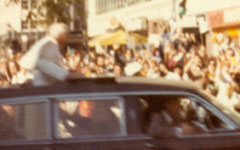| Saint and Doctor April 4, 2005 I never tire of telling my fellow Catholics--and any others of good will not living in fear and loathing of organized religion, especially Romism--how extremely fortunate we are to have lived during the reign of Pope John Paul II. Here I will do so again. Indeed we are luckier than those who personally witnessed the life of Francis Assisi or who heard the homilies of Dominic and Thomas a thousand years ago. John Paul II is being remembered for running up the papal odometer, his outreach, his apologies, his outspoken pleas for peace and human rights. However his most significant achievements are things that most people have difficulty grasping. These are the catechism he authorized, his writings, his books, his speeches, the lectures he gave at his Wednesday afternoon audiences. It was during these latter that he expounded his Theology of the Body that George Weigel has so wonderfully characterized as a "theological time-bomb for the next millennium." John Paul planted several time bombs. He is the greatest philosopher since Thomas Aquinas, augmenting Catholic wisdom with his own teaching that human experience is as important a source of truth about ourselves as is objective reasoning. His incredible life played out under Nazism, in the shadow of Auschwitz, and under Communism as well. He personally saw and resisted the atrocities inspired by defective views of Man that reduce human beings to animals, organisms in a universe without any connection to the divine. Sadly such defective views have outlasted Nazism and Communism and have found new and comfortable homes in Europe and the United States, particularly among the intelligentsia, media and let's not leave out the good ol' masses. This past week, duly constituted branches of state and federal governments starved a woman to death in full view of the world. People who would have rioted if such a barbaric end were visited upon a puppy dog or a Gitmo detainee threw fits and ruptured capillaries over Tom DeLay (R-Tex.). Others prattled on about "a government of laws" and declared that they wouldn't "want to live like that." John Paul II's teachings about human dignity and the Culture of Life are already very much needed and will be, I fear, needed even moreso in the near future. The second greatest bequest of John Paul is his young people. The media, through some of the Catholic "experts" they manage to dig up, has been reporting that young people admire John Paul but have little use for the Church's moral teaching on sexuality. Unfortunately, even some Catholics in ministry have adopted the view that young folks are inevitably easily bored ”midriffs” and “mooks” (as they are called by the marketers who manipulate them) and egocentric bundles of uncontrollable sexual appetite that is best dealt with by feeding it. This is a belief arising from the aforementioned view that people are mere animals. Nowhere are its consequences more evident and more tragic than in the handling of teen sexuality in public education. The truth is, there are many young people, a tiny minority of all young people to be sure, who not only admire the pope but see him as a role model, eat up every word he has issued and share his love for the church, its wisdom, moral teachings and devotions. I’ve seen 13-year-olds who should be bored and acting up touring through the Shrine* eagerly snapping up pictures of the chapel altars. I’ve known several who attended every recent World Youth Day and studied at the local John Paul II Institute for Marriage and Family Studies, one of several that the pope established around the world. The graduates of these institutes alone are enough to have a significant impact on the Church and civilization. More young men and women, inspired by John Paul are going into religious life. Expect to see more priests and nuns actually wearing “blacks” and habits in future years. The harvest is still great and the workers are still few, but thanks to Pope St. John Paul II, Doctor of the Church, there are great workers with great tools up and coming. *The Basilica of the Shrine of The Immaculate Conception in Washington, DC. See also: |
 |
| In a fuzzy photo I took with a cheap camera, Pope John Paul II barrels across K St. on his way from the White House to St. Matthew's Cathedral. This was his first American visit in October, 1979. |
My Own Encounter: A Little Dose of Personalism On October 2, 1979, measurable snow fell in Washington, DC, but by the time Pope John Paul II visited a few days later, the glorious weather of early fall had returned. We caught the pontiff motoring from the White House to St. Matthew’s Cathedral and back. As we awaited his return to Jimmy Carter, I stood on a wall at 17th & Penn., camera ready. Unfortunately my Canon AE-1 with telephoto and power-winder were a few years in the future. As the pope came by, I furiously snapped and wound as fast as my thumb and forefinger could work. Through the viewfinder, I could see John Paul II looking right at me and smiling. It was amazing how he was clearly aware of me, one 18-year-old face in a huge crowd. My camera was not up to capturing that precious moment, but my mind will never let it go. John Paul II's Mistakes? Opus Dei, only in existence since 1928, is pushing eight more of its members, non-martyrs, for sainthood. Saints do come in clusters but eight in one order is like having eight Cal Ripkens in major league baseball in 75 years. It strains credibility and doesn’t help the image of an organization that appears to be much more interested in growing its numbers and establishing its legitimacy than in doing anything substantive for the church. |